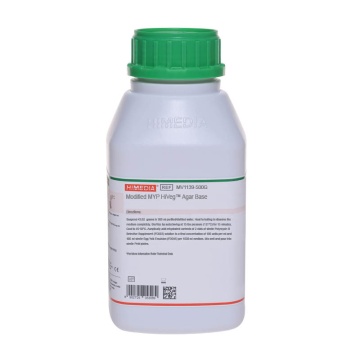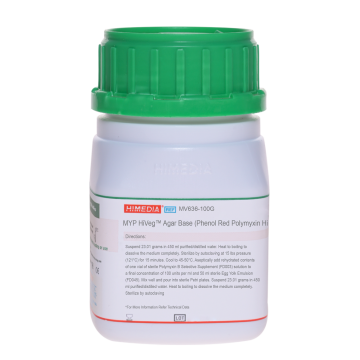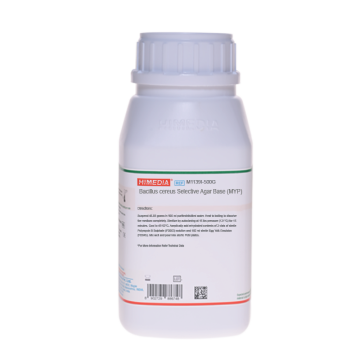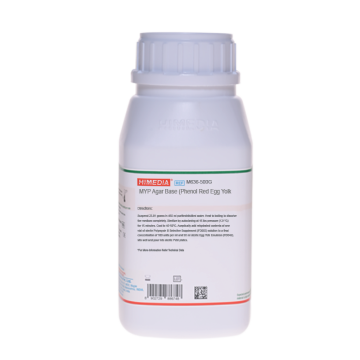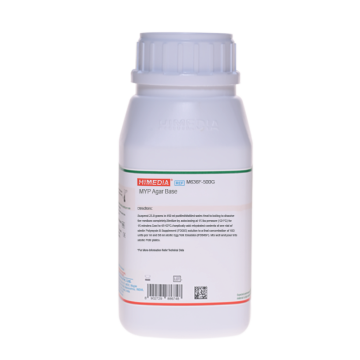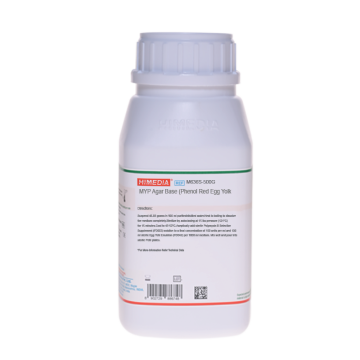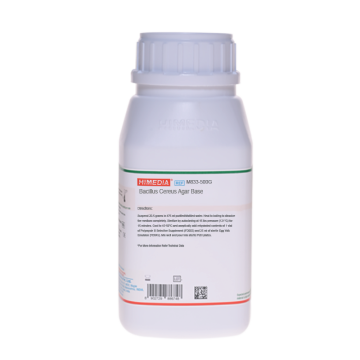 Your enquiry has been submitted
Your enquiry has been submitted
Modified MYP Agar Base
Intended Use:
Recommended for isolation and identification of Bacillus species and pathogenic Staphylococci.
Composition**
| Ingredients | g/L |
|---|---|
| Peptone | 10.000 |
| HM extract# | 1.000 |
| D-Mannitol | 10.000 |
| Sodium chloride | 10.000 |
| Phenol red | 0.025 |
| Agar | 12.000 |
| Final pH (at 25°C) | 7.1±0.2 |
**Formula adjusted, standardized to suit performance parameters
# Equivalent to Meat extract
Directions
Suspend 43.02 grams in 900 ml purified/distilled water. Heat to boiling to dissolve the medium completely. Sterilize by autoclaving at 15 lbs pressure (121°C) for 15 minutes. Cool to 45-50°C. Aseptically add rehydrated contents of 2 vials of sterile PolyB Selective Supplement (FD003) solution to a final concentration of 100 units per ml and 100 ml sterile Egg Yolk Emulsion (FD045) per 1000 ml medium. Mix well and pour into sterile Petri plates.
Principle And Interpretation
Bacillus cereus is ubiquitously present in soil, vegetation water and dust. It has been isolated from a large variety of foods, including vegetables, meat, cereals, pasteurized fresh milk and powdered milk (1,2,3) and processed foods. Under favorable conditions, the organism multiplies and causes gastrointestinal illness (3). It is implicated in two different forms of food poisoning; an emetic illness and a diarrheal illness. The emetic illness is mediated by a highly stable toxin that survives high temperature, exposure to trypsin, pepsin and pH extremes. The diarrheal illness is mediated by a heat and acid labile enterotoxin.
Lecithinase activity is the key reaction in the differential identification of B.cereus, the most commonly encountered and important species in clinical laboratories, from the majority of the other Bacillus species. If unknown isolate produces lecithinase, Bacillus cereus can be presumptively identified by also observing colonial morphology, hemolytic reactivity and motility tests. When present in large numbers in certain foodstuffs, B. cereus can produce metabolites responsible for the clinical symptoms of food poisoning (4). This medium differentiates B. cereus from other bacteria based on the basis of lecithinase activity, mannitol fermentation and resistance to polymyxin (FD003). Modified MYP Agar has similar composition to MYP Agar except agar concentration.
Modified MYP Agar Base contains peptone and HM extract, which provide nitrogen and carbon source, long chain amino acids, vitamins and other essential growth nutrients. Mannitol fermentation can be detected by phenol red, which yields yellow colour to the mannitol fermenting colonies due to acid production. Added egg yolk emulsion helps in differentiation of lecithinase producing colonies, which are surrounded by a zone of white precipitate. Addition of PolyB Selective Supplement (FD003) helps to restrict growth of gram-negative bacteria such as Escherichia coli and Pseudomonas aeruginosa. These differentiating media allow differentiation of B.cereus from other Bacillus species by its inability to ferment mannitol and poor sporulation. B.cereus dissimilates egg yolk and gives rise to typical bacilli form colonies with reddish zones and white halos. Acid produced by organisms other than B.cereus often diffuse through the medium, making it difficult to distinguish between mannitol fermenters and non-fermenters. So it is advised to transfer the suspected colonies to a fresh medium to visualize the true reaction. Colonies from Modified MYP Agar Base are subcultured on Nutrient Agar and incubated at 30°C for 24 hours to observe/determine vegetative cells, sporangium and spore morphology and lipid globules within vegetative cell.
Type of specimen
Clinical samples - Skin lesions, respiratory secretions.; Food samples; Water samples
Specimen Collection and Handling:
For clinical samples follow appropriate techniques for handling specimens as per established guidelines (5,6).
For food samples, follow appropriate techniques for sample collection and processing as per guidelines (7).
For water samples, follow appropriate techniques for sample collection, processing as per guidelines and local standards (9). After use, contaminated materials must be sterilized by autoclaving before discarding.
Warning and Precautions :
In Vitro diagnostic Use. For professional use only. Read the label before opening the container. Wear protective gloves/protective clothing/eye protection/face protection. Follow good microbiological lab practices while handling specimens and culture. Standard precautions as per established guidelines should be followed while handling clinical specimens. Safety guidelines may be referred in individual safety data sheets.
Limitations :
- If unknown isolate produces lecithinase, Bacillus cereus can be presumptively identified by also observing colonial morphology, hemolytic reactivity and motility tests.
- Individual organisms differ in their growth requirement and may show variable growth patterns on the medium.
- Each lot of the medium has been tested for the organisms specified on the COA. It is recommended to users to validate the medium for any specific microorganism other than mentioned in the COA based on the user's unique requirement.
Performance and Evaluation
Performance of the medium is expected when used as per the direction on the label within the expiry period when stored at recommended temperature.
Quality Control
Appearance Light yellow to pinkish purple homogeneous free flowing powder
Gelling Firm, comparable with 1.2% Agar gel
Colour and Clarity of prepared medium Basal medium : Red coloured clear to slightly opalescent gel. After Addition of Egg Yolk Emulsion (FD045) : Light orange coloured opaque gel forms in Petri plates
Reaction Reaction of 4.3% w/v aqueous solution at 25°C. pH: 7.1±0.2
pH 6.90-7.30
Cultural Response
Cultural characteristics observed with added Egg Yolk Emulsion (FD045) and PolyB Selective Supplement FD003) after an incubation at 32°C for 18-40 hours.
| Organism | Inoculum (CFU) | Growth | Recovery | Colour of colony | Lecithinase activity |
|---|---|---|---|---|---|
| Bacillus cereus ATCC 10876 | 50-100 | luxuriant | >=50% | red | positive, opaque zone around the colony |
| #Bacillus spizizenii ATCC 6633 (00003*) | 50-100 | luxuriant | >=50% | yellow | negative |
| Escherichia coli ATCC 25922 (00013*) | 50-100 | none-poor | <=10% | Negative | |
| Proteus mirabilis ATCC 25933 | 50-100 | luxuriant | >=50% | red | negative |
| Pseudomonas aeruginosa ATCC 27853 (00025*) | 50-100 | none-poor | <=10% | Negative | |
| Staphylococcus aureus subsp. aureus ATCC 25923 (00034*) | 50-100 | luxuriant | >=50% | yellow | positive, opaque zone around the colony |
Key: (*) Corresponding WDCM numbers
# Formerly known as Bacillus subtilis subsp. spizizenii
Storage and Shelf Life
Store between 10-30°C in a tightly closed container and the prepared medium at 2-8°C. Use before expiry date on the label. On opening, product should be properly stored dry, after tightly capping the bottle in order to prevent lump formation due to the hygroscopic nature of the product. Improper storage of the product may lead to lump formation. Store in dry ventilated area protected from extremes of temperature and sources of ignition. Seal the container tightly after use. Product performance is best if used within stated expiry period.
Disposal
User must ensure safe disposal by autoclaving and/or incineration of used or unusable preparations of this product. Follow established laboratory procedures in disposing of infectious materials and material that comes into contact with clinical sample must be decontaminated and disposed of in accordance with current laboratory techniques (5,6).
Reference
- Bergdoll M. S., 1981, Clin. Microbiol. Newsletter 3: 85-87.
- Centers for Disease Control: Bacillus cereus- Maine, MMWR, 35: 408-410, 1986.
- Donovan K. O., 1958, J. Appl. Bacteriol., 21:100.
- Mossel D. A. A., Koopman M. J. and Jongerium E., 1967, Appl. Microbiol, 15:650.
- Isenberg, H.D. Clinical Microbiology Procedures Handbook 2nd Edition.
- Jorgensen, J.H., Pfaller, M.A., Carroll, K.C., Funke, G., Landry, M.L., Richter, S.S and Warnock., D.W. (2015) Manual of Clinical Microbiology, 11th Edition. Vol. 1.
- Salfinger Y., and Tortorello M.L., 2015, Compendium of Methods for the Microbiological Examination of Foods, 5th Ed., American Public Health Association, Washington, D.C.
- Lipps WC, Braun-Howland EB, Baxter TE, eds. Standard methods for the Examination of Water and Wastewater, 24th ed. Washington DC:APHA Press; 2023.
| Product Name | Modified MYP Agar Base |
|---|---|
| SKU | M1139 |
| Product Type | Regular |
| Physical Form | Powder |
| Origin | Animal |
| Packaging type | HDPE |
| References | 1.Bergdoll M. S., 1981, Clin. Microbiol. Newsletter 3: 85-87.2.Centers for Disease Control: Bacillus cereus- Maine, MMWR, 35: 408-410, 1986.3.Mossel D. A. A., Koopman M. J. and Jongerium E., 1967, Appl. Microbiol, 15:650.4.Downes F. P. and Ito K., (Eds.), 2001, Compendium of Methods for the Microbiological Examination of Foods, 4th Ed.,APHA, Washington, D.C.5.Nygren B., 1962, Acta Path. Microbiol. Scand., 56: Suppl. 1.6.Donovan K. O., 1958, J. Appl. Bacteriol., 21:100.7.Colimer A. R., 1948, J. Bacteriol., 55:777.8.Rhodehamel J. and Harmon S. M., 1995, FDA Bacteriological Analytical Manual, 8th Ed., AOAC International,Gaithersburg, Md.9.International Organization for Standardization (ISO), 1993, Draft ISO/DIS 7932. |
| Customized Product Available | No |




